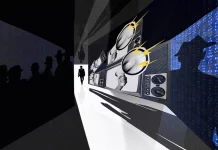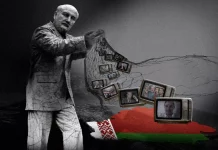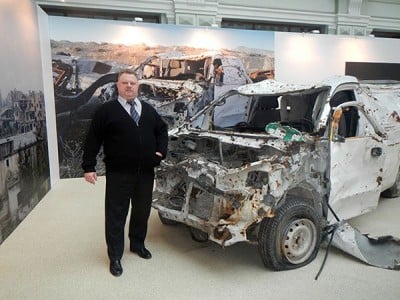
Russian ultranationalists are trying to buy Western journalists: who is behind all of this?
In the summer of 2014, a photographic exhibition on the conflicts in Ukraine and Syria appeared in Berlin and Brussels. Its advertising promised to present a “balanced, truthful picture.” The organizers meticulously disguised their identities. At the same time, they offered huge amounts of money to Western journalists without mentioning the conditions. The Kentrails research collective, an antifascist watchgroup, has researched the exhibition’s background and uncovered a propaganda network in which Russian right-wing extremists collaborate with the Kremlin-associated St. Petersburg “troll factory” in an attempt to impact the Western public.
On 23 December 2013 a photographic exhibition called Material evidence. Syria (“ВеЩдоки. Сирия”) opened in Moscow. It was organized by the periodical Zhurnalistskaya Pravda (ZhP, Eng. “Journalistic Truth”) – this was announced by the ultranationalist magazine Zavtra [1] (Eng. „Tomorrow“) on the same day. A slideshow in the article shows a number of photos of the event, including one showing one of the lecturers in front of a poster with both the logo of ZhP and the logo of the exhibition[2].
The man can clearly be identified as Vladislav Shurygin, a Zavtra editor[3] and editor-in-chief of ZhP[4]. One day later, Shurygin himself in his blog boasted[5]: „We have opened a great exhibition!“ He continues by explicitly naming ZhP as the initiator of the project and by explaining that it was one of the exhibition’s purposes to show that the Syrian government with Russia’s support conducts a fight against „thugs and mercenaries.“ These would be financed by „Islamist extremist sects“ from Saudi Arabia and Qatar.
The exhibition Material evidence. Syria should also be shown in the North Caucasus as soon as possible. One photo shows the photographer Aybulat Akbutin, another one shows Shurygin in person in front of a notable exhibit: a wrecked white minibus. On 10 January 2014, Zhurnalistskaya Pravda covers the exhibition again[6]. The photos shown there would have been created on a research trip, in which the photographers Aybulat Akbutin[7] and Halit Safin[8] would have participated as well as the „military correspondent“ Ilja Kramnik[9] and another, unnamed man who was in charge of security. They would also have brought exhibits home from the trip. According to Aybulat Akbutin, it was especially difficult to transport the minibus destroyed in a bomb attack from Syria to Moscow.
On tour in Russia
On 15-25 February, Material evidence. Syria was shown in the Russian town of Ufa, capital of the constituent republic of Bashkortostan in the Volga region. In one of the pictures of the exhibition the white minibus can be clearly spotted again [10].
Apart from the photographers Akbutin and Safin, also the deputy chief editor of Zhurnalistskaya Pravda, Denis Tukmakov, was present, who, on this occasion, gave an interview to his own magazine [11]. In it, he stated that Russian citizens would have to understand that from the USSR’s dissolution onward, war was coming closer and closer. Russia was on the radar screen of international terrorism, which aimed at establishing a „New World Order.“ The biggest threat, according to him, was lurking in the Volga region and Northern Caucasus.
On February 28, Denis Tukmakov posted a picture in Facebook showing him guiding Rustem Chamitow, President of Bashkortostan, through the exhibition room [12]. At the beginning of March, the exhibition reached Grozny, the capital of the North Caucasian constituent republic of Chechnya, and it was also shown there for ten days. At the vernissage on March 7, Syria’s ambassador Riad Haddad voiced his appreciation for Chechnya’s tyrant Ramzan Kadyrov in front of journalists and clerics as well as the parliament’s speaker, Dukuvakha Abdurakhmanov. Haddad called for concerted actions against Islamism [13]. Once more, the visitors were especially impressed by the white minibus [14].
A new topic
On 7 April 2014, the official facebook page of Zhurnalistskaya Pravda [15] had a new announcement up for its fans. The sequel of the successful Material evidence. Syria exhibition was to be opened the next day. Unlike its predecessor, this project would get its own Facebook page [16].
„There is a lot to see!“ Vladislav Shurygin wrote, as he called to visit on April 16 [17]. The new exhibition displaying pictures of Maidan street battles was to be seen in Russia’s capital during April 8-22[18].
This time, according to ZhP’s website, photographers Vasiliy Prokhanov, Dmitriy Mikhailov „and others“ spent two weeks in Kyiv. The announcement promised to provide explanations of what was going on in Ukraine at the time. Media representatives were requested to contact the given telephone number, the owner of which was only referred to as „Aleksandr“ [19]. In an interview with the newspaper Sobesednik, a man with this name was introduced as the “director” of the exhibition [20].
Russian media outlet TVC announced that the exhibition had been classified for adults only, due to its graphic content. Vladislav Shurygin told journalists that he had seen the horrors of Maidan with his own eyes while being in Ukraine with a team of journalists. Another person, who had seemingly participated in the trip, Nikita Jurchenko of ZhP depicted his impressions as well [21].
News agency RIA Novosti named Shurygin as organisator of Material evidence. Ukraine [22].
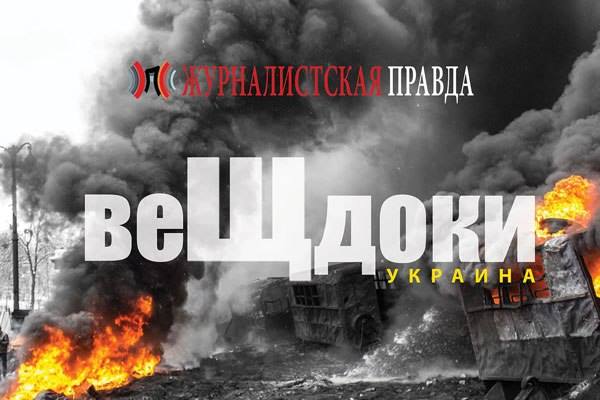
The backers: Zavtra, Zhurnalistskaya Pravda, and the Izborsk Club
Vladislav Shurygin as well as ZhP’s deputy editor-in-chief, Denis Tukmakov are very active authors for Zavtra[23].
This magazine was founded in 1990 under the title Den’ (День, Engl. „day“) by war-correspondent and novelist Aleksandr Prokhanov and renamed to Zavtra because of a ban in 1993[24].
Zavtra provides a platform to militaristic and ultra-nationalist as well as Stalinist and conservative positions, as long as they fit into the general anti-western and anti-liberal orientation. They offer a podium to various, very different Russian right figures, for example Aleksandr Dugin, Sergei Kurginyan, Aleksandr Borodai, and Igor “Strelkov” Girkin [25].
The ideological line of Journalistic Truth hardly differs from Zavtra’s. One author is worried, for example, about migrant waves squeezing out the core population, tolerance towards migrants is considered an “oral nuclear weapon” [26]. Another considers feminism to be a „battering ram against family and birth rate” [27]. Homosexuality is triggered by “gay parades” where people “make sex on the street,“ another article reads [28]. Elsewhere, patriotic ideology courses for students are demanded in order to confront “treacherous moods” in the population [29].
Since September 2012 Zavtra’s editor-in-chief, Prokhanov, also acts as head for the anti-liberal think-tank Izborsk Club (Изборский Клуб). Members of the Izborsk Club are – among others – the „neo-Eurasians” Aleksandr Dugin [30] and Valeriy Korovin [31], as well as Nataliya Narochnitskaya [32] of Paris-based Institute of Democracy and Cooperation, the revisionist Nikolai Starikov [33] and various other right-wing intellectuals.
It comes to no surprise that ZhP’s editor-in-chief, Vladislav Shurygin [34] can also be found among them. The Izborsk club is close to the Kremlin and possesses substantial financial resources [35].
Into the West
In mid-May 2014, the exhibition Material Evidence was opened in Brussels. A Spanish „journalist and publisher“ named Jesús Ballesteros, who acted as a „co-organizer“ now appeared out of the blue in Russian media outlets[36]. In addition, a photographer named Vasiliy Prokhanov explained now that it had been necessary to operate conspiratorially to prevent the exhibition from being obstructed (without saying by whom). For this reason, the Western press would not have been informed in advance.
Prokhanov is also an editor of Zavtra [37] and a member of the Izborsk Club [38]. He told the Russian Channel One that the photographers’ identities would have to be kept secret because they could be endangered in their continuing work in conflict areas. However, Ballesteros could not be held back from reporting about his participation in the Kyiv trip [39]. Photographer Halit Safin, who had stayed back in Russia, apparently also did not know about this new instruction when he told the news portal bashinform.ru that he had been present in Kyiv and that he had added ten Maidan pictures to the current Brussels exhibition [40].
Again, the organizers complained about the extra difficulties they had in bringing the white minibus through customs [41].
Conspirative Actions
In early June, the exhibition Material Evidence (in Russian media: „ВеЩдоки. Сирия. Украина“, Engl. „Material evidence. Syria. Ukraine“) reached the German capital. Jesus Ballesteros now acted as the sole curator [42]. On June 2, he gave a speech at the „Picket for peace,“ a conspiracy-ideological event held every Monday and organized by Lars Mährholz to promote the exhibition [43]. The organizers had rented an event location[44].
Speaking to the news agency RIA FAN, Ballesteros praised the support given by Russia for the Syrian ruler Baschar-al-Assad. In Berlin, it would have been difficult to even find a location for the exhibition, as local authorities would put obstacles into the organizers’ path [45]; the image the public had of conflicts such as those in Syria and Ukraine would be influenced by the USA [46], the exhibition organizer said. The photographers participating in his project wouldn’t strive for fame, but only for the truth (and thus would remain anonymous) [47].
On June 25, the Coop Anti-War Café organized an event in the framework of the exhibition [48]. The Coop is run by Heiner Bücker [49] and had already attracted attention in 2008 as a meeting spot of conspiracy theorists when large quantities of DVD copies of the 9/11 truther film Loose change had been distributed in Berlin from the café for free [50].
Bücker interviewed a German photographer named Benjamin Hiller for his video channel antikrieg.tv in mid-June. Hiller now appeared as a spokesman of Material Evidence and claimed to have come to the project only shortly before, but that he would have hit it off with the exhibition makers right away, because like them, he had felt that the reporting on Ukraine in Western media was truncated and one-sided, especially as far as right-wing extremists on Maidan were concerned. In that interview a „grant“ was mentioned which would be paid to journalists and bloggers [51].
Only a few weeks after this interview, Heiner Bücker once again appeared in the spotlights by organizing a book presentation with two Russian authors in Berlin who claimed to be experts on Ukrainian right-wing extremists, but were paradoxically from the neo-Nazi scene themselves [52] and also spread anti-semitic conspiracy theories in their new book [53]. However, despite a certain similarity between both events, there appears to be no direct connection to Material Evidence.
Money for “the truth“
At the latest, from the Berlin exhibition on the project expanded its activity field and now also offered money “to support journalists all over the world who are ready to compile unique and truthful reports about the situation in countries hit by civil wars.“ Those interested were supposed to participate in a competition. The available amounts were listed on a corresponding website:
“Journalistic investigation – 20 000 euros
Documentary 15 000 euros
Special Report 10 000 euros
PhotoReport 10 000 euros
News piece 10 000 euros
Article 10 000 euros“[54]
Benjamin Hiller’s Berlin address is identical with the one of Coterie Collective [55], a small group of independent journalists including Hiller [56], Flo Smith [57] and Julian Haas [58]. Apparently, these three are from the left-wing, alternative scene. Connections to Russia or Eastern Europe in general cannot be discerned. Flo Smith spent time in Iraq in July 2014 and took photos there in the name of Material Evidence [59]. Evidently, Material Evidence participated in financing this research trip. Benjamin Hiller has recently confirmed as much to us in an e-mail.
New York
From 21 September to 11 October 2014, the Syria-Ukraine version of Material Evidence was shown in New York, now called Material Evidence. Syria, Ukraine… who’s next? with Benjamin Hiller again acting as its curator [60]. Speaking to Russian journalists [61] and a New York Times reporter [62], he now claimed the exhibition was financed through crowdfunding.
On location, Hiller gave several interviews, including talking to conspiracy-theorist Luke Rudkowski of We Are Change [63]. The corresponding YouTube video was linked to from the official Facebook page of Material Evidence [64]. Luke Rudkowski is considered to be part of the 9/11-Truth-Movement [65]. Only a few days before the interview went online, he had posted an antisemitic caricature on his private Facebook page [66] and on September 11, two videos as well as a confusing interview with Wayne Madsen about Syria on his YouTube channel [67] [68]. Apparently, this caused no one at Material Evidence to doubt Rudkowski’s integrity.
On September 27, Benjamin Hiller held a lecture in the exhibition location – on the topic of ethics in journalism, of all things [69].
In early October, an incident happened that brought Material Evidence into Western media headlines for the first time: three individuals rioted the exhibition, pepper-sprayed Hiller and left behind several notes carrying symbols of the Ukrainian Azov battalion, which has received notoriety for its neo-Nazi members. The perpetrators fled without being identified [70]. Russian media outlets blamed Ukrainian right-wing extremists for the attack [71].
In fact, the New York exhibition had roused the ire of the Ukrainian diapora [72]. US anti-fascists after the attack directed attention [73] to the fact that a division of the nationalist Right Sector exists in the US [74]. This organization had held a picket in New York in early September [75] (unrelated to the exhibition). However, it remained unclear whether the attack on Material Evidence had indeed been conducted by individuals from this environment, as the perpetrators were never identified.
![Financed through crowdfunding? In New York, “Material Evidence” was advertised for on 30 buses and 250 subway posters [78] [94]](http://www.stopfake.org/content/uploads/2015/09/a27fe-bus.jpg.pagespeed.ce_.DwuiYObKLr.jpg)
First questions concerning sponsors
The incident raised some interest in the show. However, the exhibition’s organizers were now faced with the suspicion of being funded by the Russian government. Which Hiller clearly denied when he told BuzzFeed: “Nobody would ask if a Pro-Maidan exhibition or images showing the Free Syrian Army […] is funded, lets say, by Saudi Arabia, the US or NATO states,” he wrote in an email. According to Hiller, his project was funded by private donations: “Mostly people approach us directly after visiting the exhibition, ask us how they can support us with money, if they can spread the word etc.” [76] In a press release the curator defended the exhibitions against critics and “lies” [77]. Earlier, his assistant Svetlana Andreeva had put a particularly spectacular story on record regarding funding and told Gawker: In the course of the Berlin exhibition an inconspicuous looking man, a “silent guy,“ had handed over a bag full of cash as a donation without any further explanation, since he liked the concept so much [78]. It is not known if anyone took this anecdote seriously.
A new exhibition
An entirely new exhibition, curated by Hiller, was first shown in Moscow from 15-29 January 2015 [79]. It was named similarly to the former exhibitions: Вещдоки. Ирак. Афганистан [80] (“Material evidence. Iraq. Afghanistan“) by Russian media. Iranian PressTV mentions crowdfunding [81]. The public press agency Rossiya Segodnya organised a press conference with Osie Greenway and Benjamin Hiller participating, and, among others, also journalists Gordana Blazevska [82] (Macedonia), Geoffrey Kamadi [83] and Jeckons Okoth from Kenia, as well as Sean Kedian [84] (South Africa).
As of February 2 the exhibition was shown in Berlin [85], among others with pictures by Osie Greenway and Flo Smith, Iraq [86]. As of March 19 it was shown in Brussels [87].
The German photographer
In the course of our research, in July 2015, we asked Benjamin Hiller about his role in the project. He would point out that he was not working for Material Evidence any longer. Although he got first doubts after the controversy following the New York exhibition, he had not taken them seriously as they “mostly came from a far-right Ukrainian spectrum.” Hiller himself did not understand “a word” of Russian, so he relied on his partners in Moscow, who claimed that Shurygin’s paper did not have anything to do with the organisation any more.
“I did not notice that my partners were showing any far-right tendencies, neither in personal dialogues nor in their behaviour,” he writes in his email.
According to Hiller, there hadn’t been attempts of influencing the Iraq/Afghanistan exhibition which he designed. But at a press conference in Moscow in January 2015, he realized how close the connections between his organisation and the Russian state were. This was where he saw Vladislav Shurygin for the first and last time. So he asked Svetlana Andreeva to provide detailed information about the organization and to comment on the allegations. As he didn’t receive an answer, he left the project after the Berlin Iraq/Afghanistan exhibition.
Nonetheless, his personal data was used without his knowledge for purchases for the Brussels exhibition in March. The bills have never been paid by his former business partners in Russia, they simply left him with the debts. The new spokesperson of the project, a certain “Andreas” from Berlin, did not have any connection to photography, but, instead, was a loyal Putin supporter.
Follow-up projects
The follow-up exhibition ВеЩдоки. 365 дней АТО на Донбассе (“Material evidence. 365 days ATO in Donbas“) was shown over 7-19 April 2015 in Moscow [88]. This version’s setup aimed at evoking even more emotions and attracting a broad public, e.g. by using sound and light effects as well as true-to-life wax figures of wounded militants. It featured “artefacts” brought from the combat area, they got hold of a damaged white van even in the Donbas area [89].
A press release with regard to the Donbas exhibition [90] still mentions Benjamin Hiller as the curator (featuring his German mobile phone number [91]), and Svetlana Andreeva as his assistant.
Between May 20 and 22 an organization called Journalist Association for Peace, hitherto unknown, presented itself in Vienna. Osie Greenway was one of the speakers at their conference, [92]. Its concept and format bear a striking resemblance to Material Evidence, the website is even linked to their Facebook page without distinguishing between the two projects. Here, too, their ethics as journalists is being passionately hailed. Five-digit sums provided by a “grant” are also to be distributed – and the search for the organisers’ names or any legal details does not yield any results [93].
Follow the money
The blogger Mat Babiak had found out shortly after the New York incident that the domain material-evidence.com had been registered by the publishing house Фрегат (Fregat, Engl. „frigate“) and was part of a network of anti-American propaganda websites [94]. The Fregat company [95] is mentioned in the imprint of the Zhurnalistskaya Pravda periodical as its publishing house [96]. In July 2015, the British journalist Lawrence Alexander was successful in linking several pro-Russian websites to one single Google Analytics account – material-evidence.com being among these. Alexander followed the track all the way to the Internet Research Agency (IRA) in St. Petersburg, a company close to the Kremlin, infamously known as the „troll factory“ [97].
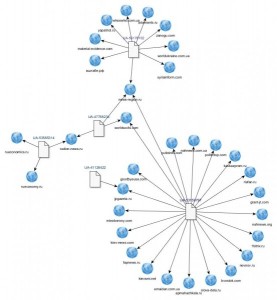
32 e-mails cover payments by IRA to the benefit of the Fregat publishing house [101]. From Excel sheets and image files attached to them it can be seen that the IRA in 2013 financed the printing of Zhurnalistskaya Pravda and paid the salaries of the publishing house’s employees [102]. In a „pre-settlement bill“ of March 2014, costs of living, business travel expenses and salaries of Alexander Prokhanov, Vladislav Shurygin and Denis Tukmakov, among others, are precisely calculated [103].
An e-mail of 5 January 2014 contains a bill summarizing several months. In the November section, one item is titled Вещдоки, it amounts to RUB 1,930,000 (back then about EUR 42,888) [104]. This immediately precedes the Syria exhibition in Moscow.
An e-mail of 10 January 2014 contains an attachment for the money-wire from a company called OOO Вещдоки (Eng.: Material Evidence LLC) to a company with the name Зодиак (Zodiac). The payment amounted to a flat four million rubles (at the exchange rate then about EUR 88,574). The purpose of use was: “Final settlement for services in the organization of an event from 20 December, 2013 until 20 January, 2014 according to invoice 1 of 1/9/2014, including VAT 18%.” [105]
From this, it can be deducted with great certainty that at least the first Moscow exhibition Material evidence. Syria was paid for with means provided by the Internet Research Agency. In general, IRA appears to finance the entire work of Zhurnalistskaya Pravda, all the way to the out-of-pocket expenses of its prominent editors.
Conclusion
The Material Evidence project has never been independent and it never pursued the goal of promoting free journalism. It was set up and coordinated by right-wing Moscow intellectuals, some of whom had pertinent military experience. At first, the organizers hired inexperienced civil photographers in Russia and enabled them to go on research trips to Syria and Ukraine. In this phase, the editors of Zhurnalistskaya Pravda openly acted as its organizers. From the beginning, there were substantial financial resources behind the project, provided by a propaganda agency that can be described as being close to the Kremlin. From May 2014 onward, the organizers attempted to win Western journalists for their cause. The promise of generous financial support in the framework of a competition served as bait. The backers now hid their identities under the pretext of wanting to protect the lives of journalists, something that did not play a role before. They chose rather little-known Western journalists as figureheads, who wouldn’t ask many questions and accepted the obvious sleaze of the whole thing. Currently, the propaganda project is continued in an altered form. It remains unclear, how many Western journalists accepted offers like these, however it is doubtful that it had a really broad effect.
By Kentrails Research collective, for Euromaidan Press



